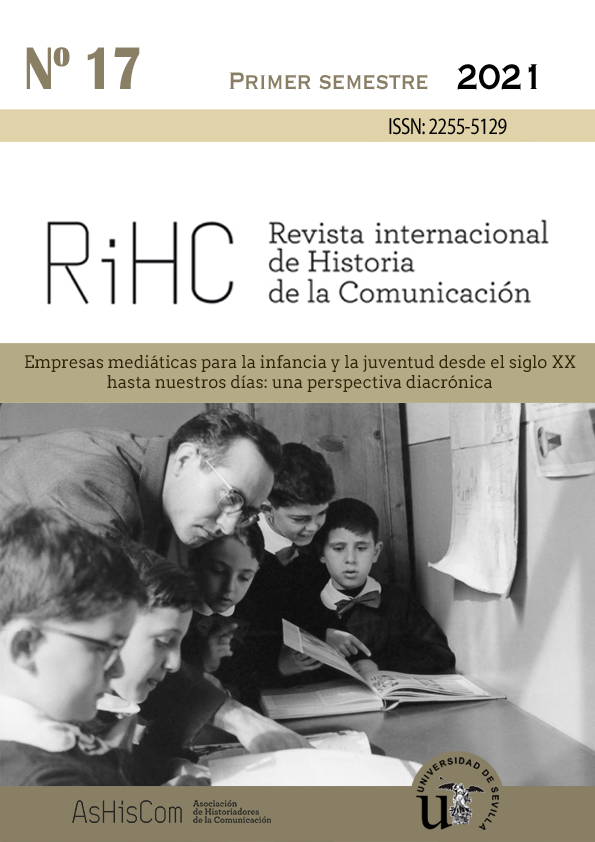Melampo & co .: the children's comic and the hierarchical stereotype of the man-animal relationship
DOI:
https://doi.org/10.12795/RiCH.2021.i17.02Keywords:
History of children's magazine, History of communication, History of culture, Speciesism, CómicAbstract
Each children's comic is a means of escape and at the same time deeply formative, because its message (explicit and implicit) is capable of generating interpretations of reality. An example is the eternal challenge between good and evil, which directs children to distinguish the right actions from the wrong ones. In the context of this role of comics in the constitution of a kind of 'guide to the underlying values of social relations', this contribution seeks to briefly define, through the analysis of some comics classics from the first half of the 20th century, what the representation of the animal world. Is it the idea (die hard) that human beings carry a "higher" consciousness and feelings that would also distinguish them from animals in the comics? Is that presumed sentimental 'inferiority' that allowed (and allows) to justify, in turn, the exploitation of the animal body is reinforced in them? How is this hierarchy expressed in the comics to strengthen (or, although more sporadically, contrast) a model attributable to the category of 'speciesism'?
Downloads
References
ARIZMENDI, M. (1975). El cómic. Madrid: Planeta
ASOR ROSA, A. (2005): Storie di animali e altri viventi. Turín: Einaudi
BARBER, T. X. (1993): The Human Natur of Birds. New York: St. Martin’s Press
BEASLEY, E. (2011) Comics’ comics. Nueva York: Mark Batty Publisher
CIANCIULLO, A. (2005): “Batte un cuore nella fattoria degli animali” en La Repubblica, (19-10-2005), p. 43
CLUTTON BROCK, J. (2017): Storia naturale della domesticazione dei mammiferi. Turín: Bollati Boringhieri
COLLODI, C. (1883): Le avventure di Pinocchio. Storia di un burattino. Florencia: Bemporad
COMA, J. (1977). Los cómics. Un arte del siglo XX. Madrid: Guadarrama
DARWIN, C. (1872): The Expression of the Emotions in Man and Animals. Londres: John Murray
DUSI, E. (2006): “Gioia e lutti, animali con l’anima” en La Repubblica, (5-2-2006), p. 27
KRIGSTEIN, BD. (2004). Comics. Seattle, Wash: Fantagraphics
LEVI, C. (2004): Le ragioni dei topi. Roma: Donzelli
MACULOTTI, M. (2015): L’invenzione dei “funny animals”. Alle origini del fumetto statunitense. Disponible en Internet (19-09-2021) www.fumettologica.it/2015/06/invenzione-funny-animals-fumetto-usa
MARTÍN MARTÍNEZ, A. (2000). Apuntes para una historia de los tebeos. Grenoble: Glenat Ediciones
MCCLOUD, S. (1994). Understanding Comics. Nueva York: HarperPerennial
PAGLIERI, C. (2008): Non son degno di Tex. Vita, morti e miracoli del mitico ranger. Venecia: Marsilio
PANKSEPP, J. (2004): Affective Neuroscience: The Foundations of Human and Animal Emotions. Nueva York: Oxford University Press
PIAGET, J. (1973): Il giudizio morale nel fanciullo. Florencia: Giunti
SINGER, P. (1975): Animal Liberation. Nueva York: Harper Collins
VILCHES, G. (2014). Breve historia del cómic. Madrid: Nowtilus
WAUGH, C. (1991). The comics. Jackson: University Press of Mississippi
Downloads
Published
How to Cite
Issue
Section
License
Copyright (c) 2021 RIHC. Revista Internacional de Historia de la Comunicación

This work is licensed under a Creative Commons Attribution-NonCommercial-ShareAlike 4.0 International License.
RiHC. Revista internacional de Historia de la Comunicación is an open access publication, offering its content under the principle that making research available to the public free of charge contributes to the greater exchange of global knowledge.
RiHC. Revista internacional de Historia de la Comunicación adheres to the various initiatives that promote access to knowledge. All content is therefore free of charge and is published under the Creative Commons Attribution-NonCommercial-ShareAlike 4.0 International license.
By virtue of this, the authors who publish in this journal accept the following conditions:
- Open access content may be freely shared (that is, copied and redistributed in any medium or format) and adapted (remixed, transformed and built upon).
- Attribution: The user of the content must give appropriate credit, provide a link to the license, and indicate if changes were made. This may be done in any reasonable manner, but not in any way that suggests the licensor endorses the user or their use.
- Non Commercial: The content may not be used for any commercial purpose.
- Share Alike: If the content is remixed, transformed or built upon, it must be distributed under the same licence as the original.
- No additional restrictions: No legal terms or technological measures may be applied that legally restrict others from doing anything the licence permits.



